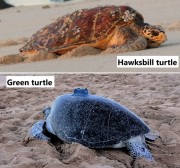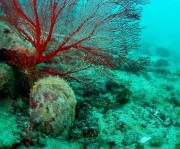Australian Institute of Marine Science
The Australian Institute of Marine Science (AIMS), Australia's tropical marine research agency, is recognised internationally for its leadership in research into tropical marine environments and their living aquatic resources.
AIMS is the host and developer of the eAtlas system.
Articles
Published on 11 June 2020

Global populations of green (IUCN listing endangered) and hawksbill (IUCN listing critically endangered) turtles are declining due to a range of threats. Australia supports some of the largest rookeries (nesting sites) for these turtles in the Indo-Pacific. Even though they've been much studied, most data that shows where these turtles spend their time around Australia remains unpublished. Here, we set out to quantify and map the important areas that turtles use to help refine these protected areas and assist with turtle conservation management.
Published on 26 May 2022
Key Ecological Features (KEFs) are parts of the marine ecosystem considered to be of particular importance for either a region's biodiversity or its ecosystem function and integrity. 13 KEFs have been defined for Australia’s North-west Marine Region, including the ‘Ancient Coastline at 125m depth contour’ (AC125). The AC125 is thought to “provide areas of hard substrate and therefore may provide sites for higher diversity and enhanced species richness relative to surrounding areas of predominantly soft sediment.” Little is known about what habitats exist on the sea floor in the AC125. Part of the reason is that the AC125 is very deep, and thus difficult to observe. The North West Shoals to Shore Research Program took underwater photographs and video of the seafloor to better understand each AC125 Area within its local context.
Published on 9 June 2020

The Silver Lipped Oyster, Pinctada maxima, forms the basis of a historical fishery in tropical Western Australia, estimated to be worth $A61 million in 2013. This fishery supplies pearl and mother of pearl markets through wild harvest of P. maxima stock, augmented more recently with aquaculture. Studies have shown that populations of P. maxima within the region are highly connected to one another. This raises the question of whether oysters located deeper than those safely visited by divers (beyond 30-40 metres) may help replenish stocks in shallower areas. At present, the extent to which P. maxima occurs at these depths (>40 metres) within the region near Eighty Mile Beach is poorly known.
Published on 9 June 2020

The North West Shoals to Shore Research Program investigated seabed habitats and their biodiversity to inform management and sustainable development of the region.
Little is known about the fish found on and around the AC125. Part of the reason is that the AC125 is very deep, and thus difficult to observe. One question to ask about a habitat is how many different species of fish are found there - this is called fish species 'richness'. We explored this question for 5 study areas spread along the vast AC125 (see map below, read the full paper here).
Published on 4 June 2020

Little is known about what fish species call the AC125 home. Part of the reason is that the AC125 is very deep, and thus difficult to observe. To fill this gap, we conducted fish relative abundance and diversity surveys across five study Areas of the AC125 using Baited Remote Underwater Video Stations (BRUVS). BRUVS were deployed on and off the AC125 at a minimum distance of 500 m between each unit. A total of 204 BRUVS deployments were conducted at depths between 62.1 m and 181.4 m across each study Area from the RV Solander.





